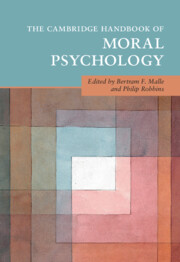Refine search
Actions for selected content:
88 results
Dirty hands, savage enemies, and bad apples: A taxonomy of war crimes apologia
-
- Journal:
- Review of International Studies , First View
- Published online by Cambridge University Press:
- 12 November 2025, pp. 1-20
-
- Article
-
- You have access
- Open access
- HTML
- Export citation
Against Causal Conditions
-
- Journal:
- Episteme , First View
- Published online by Cambridge University Press:
- 18 September 2025, pp. 1-12
-
- Article
-
- You have access
- Open access
- HTML
- Export citation
Blame Shifting in Autocracies following Large-Scale Disasters: Evidence from Turkey
-
- Journal:
- Perspectives on Politics , First View
- Published online by Cambridge University Press:
- 08 September 2025, pp. 1-24
-
- Article
-
- You have access
- Open access
- HTML
- Export citation
Chapter 5 - Forgivingness
- from Part II - Virtues of Direct Caring
-
- Book:
- Attention to Virtues
- Published online:
- 25 July 2025
- Print publication:
- 14 August 2025, pp 85-119
-
- Chapter
- Export citation
Scepticism About Epistemic Blame Scepticism
-
- Journal:
- Episteme , First View
- Published online by Cambridge University Press:
- 25 July 2025, pp. 1-15
-
- Article
-
- You have access
- Open access
- HTML
- Export citation
When it is (and is not) Blameworthy to Break the Rules
-
- Journal:
- Episteme , First View
- Published online by Cambridge University Press:
- 18 July 2025, pp. 1-14
-
- Article
-
- You have access
- Open access
- HTML
- Export citation
The impact of the level of responsibility on choices under risk: the role of blame
-
- Journal:
- Experimental Economics / Volume 22 / Issue 4 / December 2019
- Published online by Cambridge University Press:
- 14 March 2025, pp. 794-814
-
- Article
- Export citation
21 - Criminal Law, Intuitive Blame, and Moral Character
- from Part V - Applications and Extensions
-
-
- Book:
- The Cambridge Handbook of Moral Psychology
- Published online:
- 20 February 2025
- Print publication:
- 27 February 2025, pp 523-548
-
- Chapter
- Export citation
16 - Moral Communication
- from Part III - Behavior
-
-
- Book:
- The Cambridge Handbook of Moral Psychology
- Published online:
- 20 February 2025
- Print publication:
- 27 February 2025, pp 382-406
-
- Chapter
- Export citation

The Cambridge Handbook of Moral Psychology
-
- Published online:
- 20 February 2025
- Print publication:
- 27 February 2025
Harm, Context, Blame, and Significance: A Response to Eggleston, Sinnott-Armstrong, Mason, and Kagan
-
- Article
-
- You have access
- Open access
- HTML
- Export citation
Degrees and Demands
-
- Article
-
- You have access
- Open access
- HTML
- Export citation
8 - Can I Both Blame and Worship God?
- from Part III - Normative Aspects
-
-
- Book:
- The Philosophy of Worship
- Published online:
- 09 January 2025
- Print publication:
- 23 January 2025, pp 133-151
-
- Chapter
- Export citation
Revisiting Response-Dependent Responsibility
-
- Journal:
- Dialogue: Canadian Philosophical Review / Revue canadienne de philosophie / Volume 63 / Issue 3 / December 2024
- Published online by Cambridge University Press:
- 23 January 2025, pp. 433-446
-
- Article
-
- You have access
- Open access
- HTML
- Export citation
Why Does Possessing Standing to Blame Matter?
-
- Journal:
- Canadian Journal of Philosophy / Volume 54 / Issue 1 / January 2024
- Published online by Cambridge University Press:
- 10 January 2025, pp. 59-73
-
- Article
-
- You have access
- Open access
- HTML
- Export citation
A Philosopher goes to the Therapist
-
- Journal:
- Journal of the American Philosophical Association / Volume 11 / Issue 2 / June 2025
- Published online by Cambridge University Press:
- 10 January 2025, pp. 269-286
-
- Article
-
- You have access
- Open access
- HTML
- Export citation
1 - Introduction
-
- Book:
- The King Can Do No Wrong
- Published online:
- 21 November 2024
- Print publication:
- 28 November 2024, pp 1-38
-
- Chapter
-
- You have access
- Export citation
8 - The Royal Advantage in Power Sharing and Blame Shifting
-
- Book:
- The King Can Do No Wrong
- Published online:
- 21 November 2024
- Print publication:
- 28 November 2024, pp 236-276
-
- Chapter
- Export citation
5 - How Jordanians Attribute Responsibility
-
- Book:
- The King Can Do No Wrong
- Published online:
- 21 November 2024
- Print publication:
- 28 November 2024, pp 146-172
-
- Chapter
- Export citation
